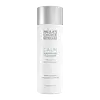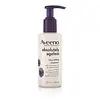Paula's Choice Calm Redness Relief Cleanser Versus Aveeno Absolutely Ageless Facial Nourishing Anti-Aging Cleanser
What's inside
What's inside
 Key Ingredients
Key Ingredients

 Benefits
Benefits

 Concerns
Concerns

 Ingredients Side-by-side
Ingredients Side-by-side

Water
Skin ConditioningDisodium Cocoamphodiacetate
CleansingButylene Glycol
HumectantCoco-Glucoside
CleansingGlycerin
HumectantXanthan Gum
EmulsifyingLimnanthes Alba Seed Oil
Skin ConditioningPEG-7 Glyceryl Cocoate
EmulsifyingArctium Majus Root Water
Skin ConditioningAllantoin
Skin ConditioningAloe Barbadensis Leaf Juice Powder
Skin ConditioningPEG-120 Methyl Glucose Dioleate
EmulsifyingTocopheryl Acetate
AntioxidantTocopherol
AntioxidantCalendula Officinalis Flower Extract
MaskingIsoamyl Laurate
EmollientPolysorbate 20
EmulsifyingPolyglyceryl-10 Laurate
Skin ConditioningEthylhexylglycerin
Skin ConditioningTetrasodium EDTA
Citric Acid
BufferingPhenoxyethanol
PreservativePotassium Sorbate
PreservativeSodium Benzoate
MaskingWater, Disodium Cocoamphodiacetate, Butylene Glycol, Coco-Glucoside, Glycerin, Xanthan Gum, Limnanthes Alba Seed Oil, PEG-7 Glyceryl Cocoate, Arctium Majus Root Water, Allantoin, Aloe Barbadensis Leaf Juice Powder, PEG-120 Methyl Glucose Dioleate, Tocopheryl Acetate, Tocopherol, Calendula Officinalis Flower Extract, Isoamyl Laurate, Polysorbate 20, Polyglyceryl-10 Laurate, Ethylhexylglycerin, Tetrasodium EDTA, Citric Acid, Phenoxyethanol, Potassium Sorbate, Sodium Benzoate
Water
Skin ConditioningGlycerin
HumectantCocamidopropyl Betaine
CleansingLauryl Glucoside
CleansingPEG-120 Methyl Glucose Dioleate
EmulsifyingPotassium Acrylates Copolymer
Disodium Lauroamphodiacetate
CleansingSodium Cocoyl Sarcosinate
CleansingCaprylyl Glycol
EmollientEthylhexylglycerin
Skin ConditioningCitric Acid
BufferingSodium Hydroxide
BufferingPotassium Sorbate
PreservativeParfum
MaskingTocopheryl Acetate
AntioxidantMaltodextrin
AbsorbentAscorbic Acid
AntioxidantRubus Fruticosus Leaf Extract
MaskingButylene Glycol
HumectantPeucedanum Graveolens Extract
TonicXanthan Gum
EmulsifyingWater, Glycerin, Cocamidopropyl Betaine, Lauryl Glucoside, PEG-120 Methyl Glucose Dioleate, Potassium Acrylates Copolymer, Disodium Lauroamphodiacetate, Sodium Cocoyl Sarcosinate, Caprylyl Glycol, Ethylhexylglycerin, Citric Acid, Sodium Hydroxide, Potassium Sorbate, Parfum, Tocopheryl Acetate, Maltodextrin, Ascorbic Acid, Rubus Fruticosus Leaf Extract, Butylene Glycol, Peucedanum Graveolens Extract, Xanthan Gum
Ingredients Explained
These ingredients are found in both products.
Ingredients higher up in an ingredient list are typically present in a larger amount.
Butylene Glycol (or BG) is used within cosmetic products for a few different reasons:
Overall, Butylene Glycol is a safe and well-rounded ingredient that works well with other ingredients.
Though this ingredient works well with most skin types, some people with sensitive skin may experience a reaction such as allergic rashes, closed comedones, or itchiness.
Learn more about Butylene GlycolCitric Acid is an alpha hydroxy acid (AHA) naturally found in citrus fruits like oranges, lemons, and limes.
Like other AHAs, citric acid can exfoliate skin by breaking down the bonds that hold dead skin cells together. This helps reveal smoother and brighter skin underneath.
However, this exfoliating effect only happens at high concentrations (20%) which can be hard to find in cosmetic products.
Due to this, citric acid is usually included in small amounts as a pH adjuster. This helps keep products slightly more acidic and compatible with skin's natural pH.
In skincare formulas, citric acid can:
While it can provide some skin benefits, research shows lactic acid and glycolic acid are generally more effective and less irritating exfoliants.
Most citric acid used in skincare today is made by fermenting sugars (usually from molasses). This synthetic version is identical to the natural citrus form but easier to stabilize and use in formulations.
Read more about some other popular AHA's here:
Learn more about Citric AcidEthylhexylglycerin (we can't pronounce this either) is commonly used as a preservative and skin softener. It is derived from glyceryl.
You might see Ethylhexylglycerin often paired with other preservatives such as phenoxyethanol. Ethylhexylglycerin has been found to increase the effectiveness of these other preservatives.
Glycerin is already naturally found in your skin. It helps moisturize and protect your skin.
A study from 2016 found glycerin to be more effective as a humectant than AHAs and hyaluronic acid.
As a humectant, it helps the skin stay hydrated by pulling moisture to your skin. The low molecular weight of glycerin allows it to pull moisture into the deeper layers of your skin.
Hydrated skin improves your skin barrier; Your skin barrier helps protect against irritants and bacteria.
Glycerin has also been found to have antimicrobial and antiviral properties. Due to these properties, glycerin is often used in wound and burn treatments.
In cosmetics, glycerin is usually derived from plants such as soybean or palm. However, it can also be sourced from animals, such as tallow or animal fat.
This ingredient is organic, colorless, odorless, and non-toxic.
Glycerin is the name for this ingredient in American English. British English uses Glycerol/Glycerine.
Learn more about GlycerinPeg-120 Methyl Glucose Dioleate is used to improve texture and stability of a product. It is sugar based and helps thicken a product.
Once applied, it also creates a thin film to trap moisture in. This helps keep your skin hydrated.
This ingredient is the polyethylene glycol ether of the diester of oleic acid and methylglucose. The 120 represents an average of 120 moles of ethylene oxide.
There is limited research on this ingredient, although it is considered safe to use in skincare products.
Learn more about PEG-120 Methyl Glucose DioleatePotassium Sorbate is a preservative used to prevent yeast and mold in products. It is commonly found in both cosmetic and food products.
This ingredient comes from potassium salt derived from sorbic acid. Sorbic acid is a natural antibiotic and effective against fungus.
Both potassium sorbate and sorbic acid can be found in baked goods, cheeses, dried meats, dried fruit, ice cream, pickles, wine, yogurt, and more.
You'll often find this ingredient used with other preservatives.
Learn more about Potassium SorbateTocopheryl Acetate is AKA Vitamin E. It is an antioxidant and protects your skin from free radicals. Free radicals damage the skin by breaking down collagen.
One study found using Tocopheryl Acetate with Vitamin C decreased the number of sunburned cells.
Tocopheryl Acetate is commonly found in both skincare and dietary supplements.
Learn more about Tocopheryl AcetateWater. It's the most common cosmetic ingredient of all. You'll usually see it at the top of ingredient lists, meaning that it makes up the largest part of the product.
So why is it so popular? Water most often acts as a solvent - this means that it helps dissolve other ingredients into the formulation.
You'll also recognize water as that liquid we all need to stay alive. If you see this, drink a glass of water. Stay hydrated!
Learn more about WaterXanthan gum is used as a stabilizer and thickener within cosmetic products. It helps give products a sticky, thick feeling - preventing them from being too runny.
On the technical side of things, xanthan gum is a polysaccharide - a combination consisting of multiple sugar molecules bonded together.
Xanthan gum is a pretty common and great ingredient. It is a natural, non-toxic, non-irritating ingredient that is also commonly used in food products.
Learn more about Xanthan Gum